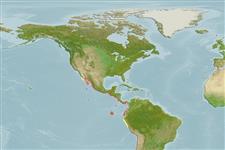>
Eupercaria/misc (Various families in series Eupercaria) >
Lutjanidae (Snappers) > Lutjaninae
Etymology: Lutjanus: Malay, ikan lutjan, name of a fish.
More on authors: Nichols & Murphy.
Environment: milieu / climate zone / rango de profundidad / distribution range
Ecología
marino asociado a arrecife; rango de profundidad ? - 40 m (Ref. 9313). Tropical; 28°N - 17°S, 115°W - 74°W (Ref. 55)
Eastern Pacific: Mexico to Peru.
Length at first maturity / Tamaño / Peso / Age
Madurez: Lm 38.0 range ? - ? cm
Max length : 95.0 cm TL macho / no sexado; (Ref. 9313); common length : 50.0 cm TL macho / no sexado; (Ref. 55); peso máximo publicado: 5.8 kg (Ref. 40637)
Short description
Claves de identificación | Morfología | Morfometría
Espinas dorsales (total) : 10; Radios blandos dorsales (total) : 13 - 14; Espinas anales: 3; Radios blandos anales: 8. Preorbital bone very broad in adults. Large specimens develop a groove from front of eye to nostrils, and on upper part of preopercle behind the eye. Preopercular notch and knob weak. Scale rows on back rising obliquely above lateral line. Color mainly red to pink with a silvery hue; the fins reddish.
Body shape (shape guide): fusiform / normal; Cross section: oval.
Adults are found over hard bottoms in inshore reef areas up to a depth of at least 80 m (Ref. 9313). Carnivorous, feed on big invertebrates and fish (Ref. 9313). They are marketed fresh or frozen because of excellent quality of flesh (Ref. 9313).
Life cycle and mating behavior
Madurez | Reproducción | Puesta | Huevos | Fecundidad | Larva
Allen, G.R., 1985. FAO Species Catalogue. Vol. 6. Snappers of the world. An annotated and illustrated catalogue of lutjanid species known to date. FAO Fish. Synop. 125(6):208 p. Rome: FAO. (Ref. 55)
IUCN Red List Status (Ref. 130435: Version 2025-1)
Threat to humans
Harmless
Human uses
Pesquerías: pesquerías de subsistencia; pesca deportiva: si
Herramientas
Special reports
Download XML
Fuentes de Internet
Estimates based on models
Preferred temperature (Referencia
123201): 22 - 28.6, mean 26.2 °C (based on 34 cells).
Phylogenetic diversity index (Referencia
82804): PD
50 = 0.5000 [Uniqueness, from 0.5 = low to 2.0 = high].
Bayesian length-weight: a=0.01479 (0.00706 - 0.03101), b=2.97 (2.80 - 3.14), in cm total length, based on LWR estimates for this Genus-body shape (Ref.
93245).
Nivel trófico (Referencia
69278): 4.0 ±0.62 se; based on food items.
Resiliencia (Referencia
120179): Medio, población duplicada en un tiempo mínimo de 1.4-4.4 años (K=0.15-0.26).
Fishing Vulnerability (Ref.
59153): Moderate vulnerability (40 of 100).
🛈
Nutrients (Ref.
124155): Calcium = 24.3 [15.2, 36.3] mg/100g; Iron = 0.299 [0.186, 0.454] mg/100g; Protein = 18.8 [17.3, 20.1] %; Omega3 = 0.116 [0.079, 0.167] g/100g; Selenium = 66.2 [43.4, 102.8] μg/100g; VitaminA = 91.6 [18.6, 329.7] μg/100g; Zinc = 0.36 [0.28, 0.50] mg/100g (wet weight);
